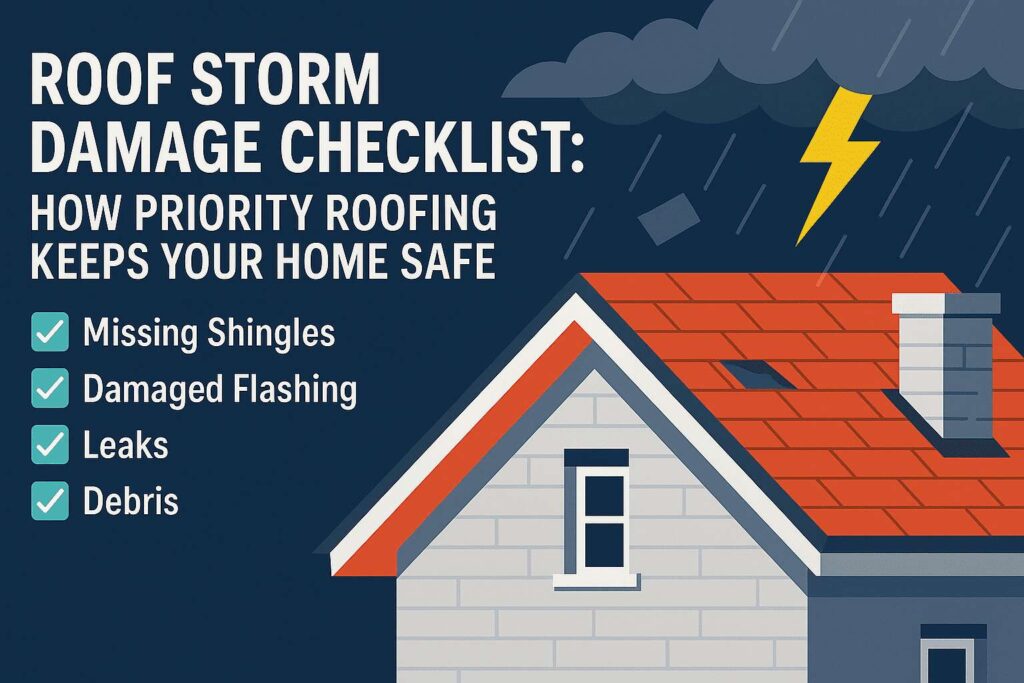Weather in the U.S. Puts Roofs to the Test
Across the United States, roofs face harsh weather of all kinds, from Gulf Coast hurricanes and Midwest hail to Rocky Mountain blizzards and strong Texas windstorms. Even a quick summer thunderstorm can loosen shingles or damage flashing, creating leaks that don’t show up until months later.
A professional inspection after a major storm isn’t just smart, it’s essential for safety, insurance compliance, and long-term protection. With more than 26 locations nationwide, Priority Roofing combines local expertise with proven storm-damage assessment methods so homeowners can move forward with confidence.
Common Causes of Roof Storm Damage
High Winds
Strong winds, whether hurricane-force (74 mph+) or sudden thunderstorm gusts, can tear off or lift shingles, break their water-tight seal, and expose underlayment or the roof deck. Once that seal is gone, rain can seep in and start hidden leaks.
Hail
A hailstorm might last only a few minutes, but it can leave lasting harm: dented shingles, bruised granules, and weakened protective layers. Without those granules, shingles age faster and lose their resistance to the sun and water.
Heavy Rain & Standing Water
When gutters clog or drainage is poor, rainwater can pool on flat or low-slope areas. Standing water seeps beneath shingles, warps decking, and accelerates rot.
Flying Debris
Branches, limbs, or even wind-blown outdoor furniture can strike shingles and flashing. Even small debris piles can trap moisture, leading to the growth of mold or mildew.
Homeowner Storm Damage Checklist
Before scheduling an inspection, you can do a quick, safe assessment from the ground.
- Stay safe first. Never climb onto a wet or storm-damaged roof. One slip can cause serious injury and may void insurance coverage.
- Walk the property perimeter. Look for missing shingles, bent flashing, dented siding, or downed branches.
- Check gutters, vents, and windows. Dents, cracks, or loose seals can signal roof impact.
- Look inside. Use a flashlight to inspect ceilings, light fixtures, and the attic for damp insulation or water stains.
- Take photos and notes. Date-stamped images make the insurance process easier and help your roofer plan repairs.
Tip: Even if everything looks fine from the ground, hidden leaks are common. A professional inspection is still the safest choice.
What to Expect From a Priority Roofing Storm Inspection
When you call Priority Roofing, our certified teams follow a proven process designed to meet U.S. insurance and building-code standards:
- Exterior & Ground Assessment: We walk the property to document visible storm impact, including missing shingles, dented gutters, and debris damage, using photos and videos for your records.
- Roof Surface Examination: Using ladders or drones, we examine shingles, flashing, and vents for hail bruising, wind uplift, and impact marks. Moisture meters and chalk tests reveal hidden weaknesses.
- Attic & Interior Check: We look for water intrusion, damp insulation, or structural stress points.
- Gutters & Drainage Review: Ensuring downspouts and fascia are clear and undamaged helps prevent future pooling or leaks.
- Comprehensive Report & Next Steps: You’ll receive a detailed, photo-rich report with repair recommendations ready for your insurer and local permit office.
After the Inspection
Priority Roofing will:
- Review findings with you in plain language.
- Provide a clear estimate for repairs or full replacement.
- Offer emergency tarping if immediate protection is needed.
- Help coordinate with your insurance company. Our team can meet the adjuster to ensure all damage is documented.
Smoother Insurance Claims
- Document everything. Photos and our inspection report help prove your claim.
- Understand coverage. Know your deductible and whether your policy covers code-required upgrades.
- File quickly. Most insurers require the claims to be submitted within 30-60 days of the storm.
Prevent Future Storm Damage
Protect your investment year-round:
- Schedule annual inspections, even when no major storms occur.
- Trim or remove overhanging tree limbs.
- Keep gutters clean for proper drainage.
- Consider impact-resistant shingles or metal roofing in storm-prone regions.
Priority Roofing can recommend durable materials and maintenance plans tailored to your state’s climate.
Take Action Today
Whether you just experienced hail in Colorado, a hurricane in Florida, or a severe windstorm in Texas, Priority Roofing is ready to help.
Schedule your free storm damage roof inspection today to keep your home safe and your insurance claim on track.



